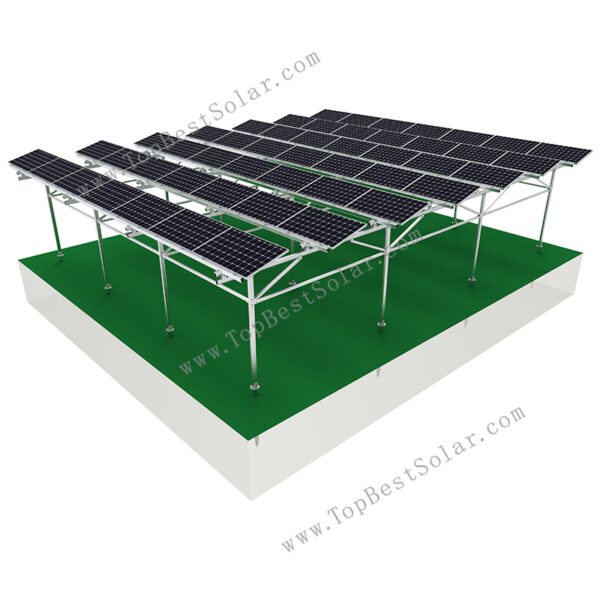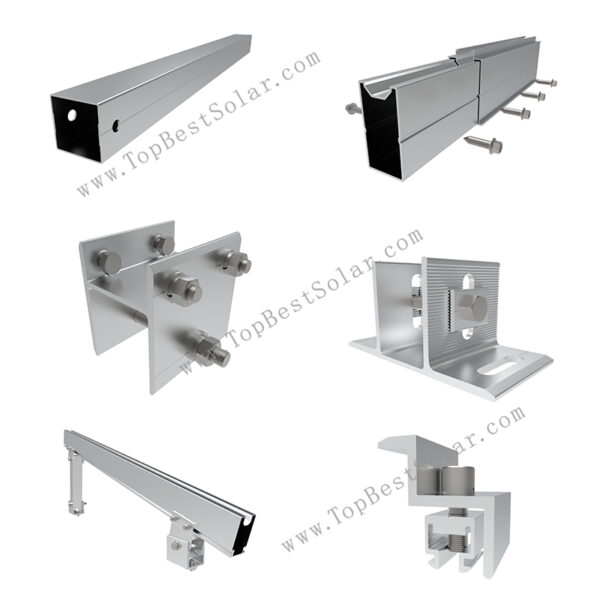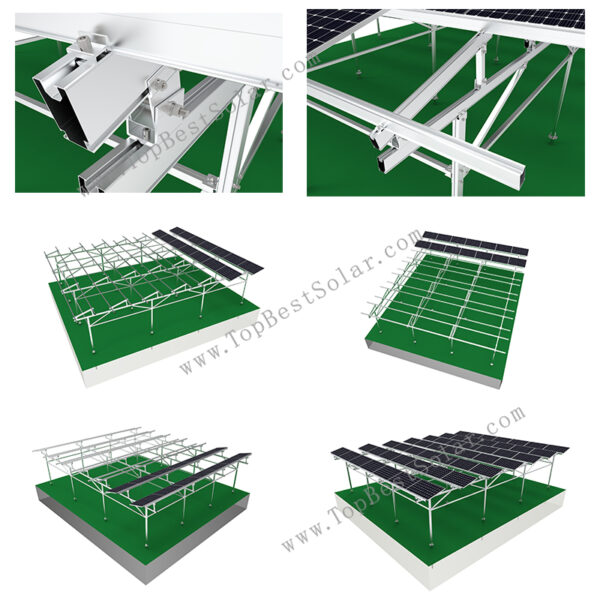Unlike rooftop solar, which is limited by space and weight, ground-mounted solar arrays pair well with agricultural operations. This setup—called “solar agriculture mounting”—lets farmers harness sunlight efficiently while preserving land for crops, livestock, or greenhouses.
What Is Solar Agriculture Ground Mounting?
Solar agriculture ground mounting involves installing solar farm mounting systems on open agricultural land. These systems are designed to coexist with farming activities.
They secure solar panels 2–3 meters above the ground using steel or aluminum supports. This allows farmers to use the space below for shade-tolerant crops like leafy greens or berries, or for livestock grazing. Alternatively, arrays can go on marginal land—unsuitable for farming—to avoid competing with food production.
At the core of this setup is the solar farm mounting system itself, which includes:
- Foundations: Concrete piers or driven piles anchor the system, critical for stability on farms.
- Railings: Aluminum or galvanized steel rails hold solar panels in place.
- Adjustable brackets: Tilt panels to optimize sun exposure, boosting energy output across seasons.
Why Solar Farm Mounting Systems Are Ideal for Agriculture
For farmers and agricultural businesses, solar farm mounting systems offer unique advantages that rooftop or tracking solar often lack.
-
Maximizes Energy Output with Flexible Placement
Agricultural land is usually unobstructed by buildings or trees, making it perfect for solar arrays. Solar farm mounting systems can face true south (in the Northern Hemisphere) and tilt to match local latitude. This optimizes sunlight absorption year-round. Additionally, unlike rooftop systems limited by orientation, these ground-mounted setups scale easily to meet large energy needs—like powering irrigation pumps or farm machinery. -
Preserves Land for Dual-Use (Agrivoltaics)
The “agrivoltaic” model combines solar energy with agriculture, and it relies on solar farm mounting systems. By elevating panels, farmers use land twice: generating electricity above while growing crops or raising livestock below. Studies show this boosts land productivity by 300–400% compared to using land for just agriculture or solar. -
Durable and Adaptable to Farm Conditions
Farms face harsh conditions: wind, rain, heavy machinery, and occasional flooding. High-quality solar farm mounting systems are built to withstand this, with:
- Galvanized steel: Resists corrosion from fertilizer runoff or humidity.
- Heavy-duty foundations: Prevent shifting in muddy or uneven terrain.
- Wind-resistant design: Rated for 120+ mph winds, key for storm-prone areas.
- Reduces Energy Costs and Improves Profitability
Agriculture is energy-intensive—irrigation, ventilation, and processing can make up 20–30% of operating costs. A solar farm mounting system generates free electricity to offset these expenses. Best of all, payback periods can be as short as 5–7 years.
How to Select the Right Solar Farm Mounting System for Agriculture
Not all solar farm mounting systems work for agriculture. When choosing one, prioritize these key factors:
- Terrain Compatibility
Farmland varies from flat fields to sloped pastures. Choose a solar farm mounting system that fits your land:
- Flat land: Standard fixed-tilt ground mounts are cost-effective and easy to install.
- Sloped land: Adjustable rail systems or pile-driven foundations keep panels level.
- Wet/muddy areas: Concrete pier foundations (instead of ground screws) prevent sinking.
- Load Capacity and Durability
Farms may see heavy snow, strong winds, or livestock activity. Look for solar farm mounting systems with:
- Snow load rating: Minimum 20 lbs/sq ft (higher for northern climates).
- Corrosion resistance: Galvanized steel or aluminum—avoid untreated steel, which rusts quickly.
- Livestock-friendly design: Smooth rails and rounded edges to prevent animal injury.
- Panel Tilt and Adjustability
Seasonal crop growth and sun angles demand flexibility. For solar farm mounting systems:
- Fixed-tilt systems: Best for permanent crops like orchards or marginal land.
- Adjustable-tilt systems: Tilt panels twice a year (spring/summer and fall/winter) to boost output by 10–15%.
- Tracking systems: Advanced option that follows the sun, increasing output by 20–25%. This works well for large commercial farms with high energy needs.
- Installation and Maintenance Ease
Farmers need systems that minimize downtime. Choose solar farm mounting systems with:
- Modular design: Easy to assemble with basic tools, cutting installation costs.
- Accessible components: Panels and wiring should be easy to reach for cleaning or repairs.
- Low maintenance: Fixed-tilt systems have no moving parts, while trackers use self-lubricating parts to reduce upkeep.
The Future of Solar Agriculture Mounting
As governments and consumers push for sustainable agriculture, solar farm mounting systems will become more integral to farming. Innovations are making the technology more accessible, too. For example, “smart” ground mounts integrate soil moisture sensors to optimize irrigation, and lightweight aluminum structures work for smaller farms.
For farmers, the choice is clear: solar farm mounting systems cut energy costs and turn underused land into income. Whether you run a small family farm or a large commercial operation, a tailored system is a step toward profitability and sustainability.
Ready to explore solar farm mounting systems for your farm? Contact a solar agriculture specialist today. They’ll assess your land, energy needs, and budget—helping you harness the sun’s power for your operation.
Follow us :instagram









